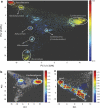Unveiling an abundant core microbiota in the human adult colon by a phylogroup-independent searching approach
- PMID: 20740026
- PMCID: PMC3105728
- DOI: 10.1038/ismej.2010.129
Unveiling an abundant core microbiota in the human adult colon by a phylogroup-independent searching approach
Abstract
The potential presence of widespread and stable bacterial core phylogroups in the human colon has promoted considerable attention. Despite major efforts, no such phylogroups have yet been identified. Therefore, using a novel phylogroup- and tree-independent approach, we present a reanalysis of 1,114,722 V2 region and 71,550 near full-length 16S rRNA sequences from a total of 210 human beings, with widespread geographic origin, ethnic background and diet, in addition to a wide range of other mammals. We found two highly prevalent core phylogroups (cores 1 and 2), belonging to the clostridial family Lachnospiraceae. These core phylogroups showed a log-normal distribution among human individuals, while non-core phylogroups showed more skewed distributions towards individuals with low levels compared with the log-normal distribution. Molecular clock analyses suggest that core 2 co-evolved with the radiation of vertebrates, while core 1 co-evolved with the mammals. Taken together, the stability, prevalence and potential functionality support the fact that the identified core phylogroups are pivotal in maintaining gut homeostasis and health.
Figures




References
-
- Alm JS, Swartz J, Lilja G, Scheynius A, Pershagen G. Atopy in children of families with an anthroposophic lifestyle. Lancet. 1999;353:1485–1488. - PubMed
-
- Blair JE, Hedges SB. Molecular phylogeny and divergence times of deuterostome animals. Mol Biol Evol. 2005;22:2275–2284. - PubMed
-
- Brodribb J, Condon RE, Cowles V, DeCosse JJ. Influence of dietary fiber on transit time, fecal composition, and myoelectrical activity of the primate right colon. Digest Dis Sci. 1980;25:260–266. - PubMed

